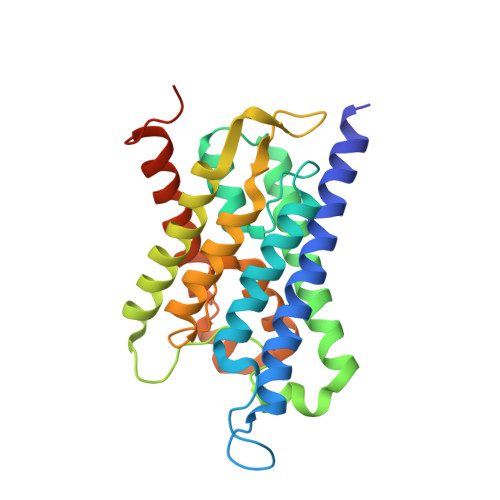Characterization of aquaporin-driven hydrogen peroxide transport.
Wang, H., Schoebel, S., Schmitz, F., Dong, H., Hedfalk, K.(2020) Biochim Biophys Acta Biomembr 1862: 183065-183065
- PubMed: 31521632
- DOI: https://doi.org/10.1016/j.bbamem.2019.183065
- Primary Citation of Related Structures:
6QIM - PubMed Abstract:
Aquaporins are membrane-intrinsic proteins initially defined as water (H 2 O) channels in all organisms and subsequently found to have multiple substrate specificities, such as hydrogen peroxide (H 2 O 2 ). H 2 O 2 is a signaling molecule that partakes in immune responses where its transport is mediated by aquaporins. To shed further light on the molecular basis of the aquaporin function in H 2 O 2 transport, we have characterized an Arabidopsis thaliana aquaporin, AtPIP2;4, recombinantly produced to high yields in Pichia pastoris. Here, we present a newly established assay that allows detection of H 2 O 2 transport by purified aquaporins reconstituted into liposomes, enabling us to compare aquaporin homologues with respect to substrate specificity. To get additional insight into the structural determinants for aquaporin-mediated H 2 O 2 transport, we solved the 3D-structure of AtPIP2;4 to 3.7 Å resolution and found structural identity to the water channel from spinach (SoPIP2;1), with the difference that Cd 2+ cation is not required to retain the closed conformation. The transport specificities of the two plant aquaporins were compared to a human homologue, AQP1. Overall, we conclude that AtPIP2;4, SoPIP2;1 and hAQP1 are all transporters of both H 2 O and H 2 O 2 , but have different efficiencies for various specificities. Notably, all three homologues expedite H 2 O transport equally well while the plant aquaporins are more permeable to H 2 O 2 than hAQP1. Comparison of the structures indicates that the observed variations in H 2 O and H 2 O 2 transport cannot be explained by differences in the monomeric pore. Possibly, the determinants for transport specificities reside in the flexible domains outside the membrane core of these channels.
Organizational Affiliation:
Department of Plant Pathology, Nanjing Agricultural University, 1 Weigang, Nanjing 210095, China; Department of Chemistry and Molecular Biology, Gothenburg University, Box 462, 405 30 Göteborg, Sweden.


















